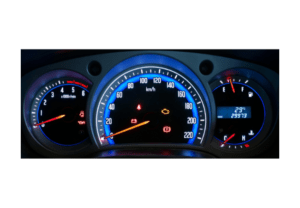The transmission oil temp light is a warning light that illuminates on the dashboard of a vehicle to indicate that the transmission fluid temperature is too high. The light typically looks like a thermometer floating in a pool of fluid. The purpose of the light is to alert the driver that the transmission is overheating, which can lead to serious and expensive problems if not addressed promptly.
It is important to address the transmission oil temp light when it comes on because the transmission is one of the most critical components of a vehicle. The transmission fluid helps to cool and lubricate the transmission, and if it gets too hot, it can break down and cause serious damage. Overheating can cause the transmission to slip, which can lead to a loss of power and a potentially dangerous situation on the road. Additionally, overheating can cause the transmission fluid to oxidize and create deposits, which can clog the fluid passages and prevent proper lubrication.

Ignoring the transmission temperature warning light can also lead to costly repairs or even a complete transmission failure. Replacing a transmission can be very expensive, and if the damage is severe enough, it may be more cost-effective to replace the entire vehicle. Therefore, it is essential to address the light as soon as it comes on to prevent any further damage to the transmission.
Contents
- 1 Understanding Transmission Oil and Its Role
- 2 What the Transmission Oil Temp Light Means
- 3 Causes of Transmission Oil Overheating
- 4 Risks and Consequences of Ignoring the Warning Light
- 5 How to Respond When the Transmission Temp Warning Light Comes On
- 6 Preventive Measures to Avoid Transmission Oil Overheating
Understanding Transmission Oil and Its Role
Transmission oil, also known as transmission fluid, is a lubricant that serves multiple purposes in a vehicle. It provides lubrication for the moving parts inside the transmission, helps to cool the transmission, and facilitates the transfer of power from the engine to the wheels. Without transmission oil, the transmission could overheat, parts could wear down quickly, and the vehicle could experience a loss of power.
The transmission oil works by circulating through the transmission and lubricating all of the moving parts, such as gears and bearings. This helps to reduce friction and prevent damage to the transmission. Additionally, transmission fluid helps to cool the transmission by absorbing heat and carrying it away from the transmission. This is especially important for high-performance vehicles or those that are towing heavy loads, as they produce more heat and require more effective cooling.
It is important to keep the transmission oil at the correct level and change it regularly according to the manufacturer’s recommendations. Neglecting the transmission oil can lead to costly repairs or even transmission failure. Regular maintenance of the transmission system, including checking the transmission oil, can help to ensure that the vehicle runs smoothly and reliably.
What the Transmission Oil Temp Light Means
The transmission oil temp light is triggered when the temperature of the transmission fluid exceeds a safe operating range. This can be caused by a variety of factors such as driving in extreme conditions, low fluid levels, or a malfunctioning transmission cooler. When the light comes on, it is a warning that the transmission may be overheating, and immediate action is needed to prevent damage to the transmission.
The transmission oil is responsible for lubricating the moving parts within the transmission system, reducing friction, and preventing overheating. Without adequate transmission oil, the transmission can seize up, causing extensive damage that can be costly to repair. The transmission fluid also helps to cool the transmission, reducing the risk of overheating. Regular maintenance of the transmission oil, such as oil changes and checking oil levels, can help to prevent problems and ensure that the transmission system is working at its best.
The automatic transmission oil temperature light is an important indicator that something may be wrong with the transmission system. Ignoring the light can lead to further problems, such as transmission failures or damage. Addressing the light when it comes on can help to identify the problem and prevent costly repairs. It is recommended to bring the vehicle to a certified mechanic or dealership as soon as possible to have the transmission system inspected and any necessary repairs completed.
Causes of Transmission Oil Overheating
Driving habits and conditions can have a significant impact on transmission oil temperature, which can trigger the transmission oil temperature warning light to come on. For example, frequently driving in heavy traffic, climbing steep hills, or towing heavy loads can cause the transmission to work harder and generate more heat. Similarly, driving at high speeds or in hot weather can also increase transmission oil temperature.
In addition to driving habits and conditions, lack of maintenance or servicing can also lead to transmission oil overheating. Over time, the transmission oil can become contaminated with debris, dirt, and other particles that can clog the system and reduce its effectiveness in regulating temperature. This can cause the transmission to overheat and trigger the transmission temperature light.
High mileage can also contribute to transmission oils overheating. As the vehicle ages, the transmission components may wear down, reducing their ability to regulate temperature effectively. This can cause the transmission oil to become overheated, triggering the transmission oil temp light to come on. To prevent this, it is important to have the transmission regularly serviced and to replace the transmission oil as recommended by the manufacturer.
Risks and Consequences of Ignoring the Warning Light
Ignoring the transmission temperature light can lead to severe consequences, such as damaging the transmission system or even complete transmission failure. Overheating of the transmission oil can cause significant damage to the transmission system, which is expensive to repair or replace. Moreover, if the warning light is ignored and the problem persists, the damage can become so severe that the entire transmission system may need to be replaced. Therefore, it is essential to address the issue promptly to avoid costly repairs and ensure safe and smooth driving.
Ignoring the transmission temperature light can also lead to safety hazards on the road. If the transmission system fails, it can cause the vehicle to suddenly stop or lose power, which can result in a serious accident. The vehicle may also become difficult to control or fail to respond correctly to acceleration or deceleration. Therefore, addressing the issue promptly not only saves money but also ensures the safety of the driver and passengers.
It is crucial to note that if the transmission oil temp light comes on, it indicates that there is an underlying problem with the transmission system. Ignoring the light can cause the problem to worsen over time, leading to more severe and costly repairs. Hence, it is crucial to take the necessary steps to address the issue promptly and prevent further damage to the transmission system and get your vehicle to a repair shop.
How to Respond When the Transmission Temp Warning Light Comes On
When the transmission oil temp light appears on your vehicle’s dashboard, it’s important to take immediate action to avoid potential damage to the transmission system. The first step is to pull over to a safe location as soon as possible. It’s important not to continue driving, as this can exacerbate the problem and potentially cause more damage to the transmission system. Once you’ve pulled over, you should check the transmission oil level to ensure that it’s not low. If the level is low, adding more transmission oil may be necessary, but be sure to check your vehicle owner’s manual or consult with a professional mechanic to ensure that you’re using the correct type of oil.
If you’ve checked the transmission oil level and it appears to be at the appropriate level, you should consider calling for roadside assistance or scheduling a maintenance appointment with a trusted mechanic. Driving with a transmission oil temperature that is too high can transmission failures, resulting in costly repairs. It’s better to be safe than sorry when it comes to transmission issues, so don’t hesitate to seek professional help if you’re unsure of what to do next.
In addition to checking the transmission oil level and seeking professional help, you may also want to consider adjusting your driving habits and conditions to prevent future issues with transmission oil temperature. For example, driving at high speeds or towing heavy loads can cause the transmission to overheat, so it’s important to avoid these situations whenever possible. Additionally, maintaining your vehicle’s transmission system with regular maintenance and fluid changes can help to prevent issues with transmission oil temperature and other related problems.
Preventive Measures to Avoid Transmission Oil Overheating
Preventive measures can be taken to prevent transmission oil from overheating, which can lead to the activation of the transmission oil temp light. One of the most important steps is to perform regular maintenance on the vehicle. This includes regular oil changes and inspections of the transmission fluid to ensure it is at the proper level and not contaminated. A qualified mechanic can also inspect the transmission system for any signs of wear or damage that could lead to overheating.
Driving habits and conditions can also impact transmission oil temperature. Drivers should avoid harsh acceleration and braking, which can put unnecessary stress on the transmission system. Additionally, driving in extreme temperatures, such as during the summer months or in cold weather, can also impact transmission oil temperature. In these cases, it may be necessary to adjust driving habits or seek alternative modes of transportation to prevent damage to the transmission system.
Taking preventive measures is important in avoiding costly repairs or replacements. Ignoring the transmission oil temp light can result in severe damage to the transmission system, which can be expensive to repair or replace. By performing regular maintenance and adjusting driving habits, drivers can help prevent the transmission oil temperature light from coming on and ensure the longevity and reliability of their vehicle.
Conclusion
The transmission oil temp light is an important warning sign that should not be ignored. Transmission oil plays a vital role in keeping the transmission system functioning properly, and when it overheats, serious damage can occur. It is essential to address the issue promptly by pulling over and checking the transmission oil level, and taking additional steps as needed, such as calling for roadside assistance or scheduling a maintenance appointment.
To prevent transmission oil from overheating, regular maintenance is key. This includes changing the transmission oil according to the manufacturer’s recommended schedule and ensuring that the correct type of fluid is used. Driving habits and conditions can also impact transmission oil temperature, so adjusting driving habits, such as avoiding heavy loads or hills, can help prevent overheating.
Paying attention to the transmission oil temp light and taking preventive measures to maintain a healthy transmission system can save car owners from costly repairs or replacements. It is crucial to address the light promptly and take necessary steps to prevent overheating in the future. By following these recommendations, Honda owners can ensure the longevity and reliability of their vehicles.

3 thoughts on “Transmission Oil Temp Light – Learn What it Means and How to Prevent It”
Comments are closed.